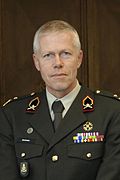| Chief of Defence | |
|---|---|
| Commandant der Strijdkrachten (Dutch) | |
 Flag of the Chief of Defence | |
| Armed forces of the Netherlands | |
| Style | His Excellency |
| Abbreviation | CDS |
| Member of | Central Staff |
| Reports to | Minister of Defence |
| Precursor | Chief of the Defence Staff |
| Formation | 5 September 2005 |
| First holder | General Dick Berlijn |
| Deputy | Vice Chief of Defence |
| Website | Chief of Defence |
The Chief of Defence (Dutch : Commandant der Strijdkrachten, CDS) is the highest-ranking officer in the Netherlands Armed Forces and is the principal military advisor to the minister of defence. On behalf of the minister of defence, he is responsible for operational policy, strategic planning and for preparing and executing military operations carried out by the armed forces. The chief of defence is in charge of the central staff and is the direct commanding officer of all the commanders of the branches of the armed forces. In this capacity, the chief of defence directs all the activities of the Royal Netherlands Army, the Royal Netherlands Navy and Royal Netherlands Air and Space Force. He is also in charge of the Royal Netherlands Marechaussee, when it is operating under the guise of the minister of defence.
Contents
- History
- Responsibilities
- List of chiefs of the defence staff / chiefs of defence
- Commander-in-chief of the Armed forces (1914–1949)
- Chairman of the United Defence Staff (1949–1976)
- Chiefs of the Defence Staff (1976–2005)
- Chiefs of the Defence (2005–present)
- List of vice chiefs of defence
- References
- External links




































